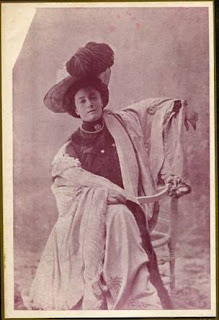with Roberto Stagno in ''Cavalleria Rusticana''
She was an Italian soprano and one of the best-known opera singers of the late 19th century. She had a particular affinity with the verismo repertoire and was renowned more for her charismatic acting than for the quality of her voice. Matilda Cesira was Bellincioni's real name. She was born in Monza, Italy, in 1864. Both her parents were singers, and after receiving training from them, she made her operatic debut in Naples in 1880. She went on to sing extensively in Europe and South America during the next two decades, although she would appear only once in London—at the Royal Opera House, Covent Garden—in 1895. Despite her fame, she never performed at America's foremost operatic venue, the New York Metropolitan Opera. Italy's leading composer, Giuseppe Verdi, admired Bellincioni's acting ability. Verdi had encountered her in 1886 when she performed Violetta in his opera La traviata at La Scala, Milan. Evidently, however, he was not so impressed by her vocal technique because he did not elect to cast her to sing the part of Desdemona at the premiere of Otello the following year. On the other hand, Bellincioni's histrionic manner, accentuated diction and arresting stage presence were to prove ideally suited to a melodramatic new style of Italian opera known as verismo, which became popular during the 1890s. She sang this type of music with great passion, although her actual voice was not particularly large in size or ripe in tone, and marred by a distinct flutter. (See Scott, cited below.) On 17 May 1890, she created the role of Santuzza in Pietro Mascagni's landmark verismo work Cavalleria Rusticana when it premiered in Rome. Her common-law spouse Roberto Stagno, a prominent tenor from Sicily, sang opposite her in the role of Turiddu at that same premiere performance: they had met on a tour of Argentina in 1886. Bellincioni was also the first soprano to perform the title role in another key verismo opera, Umberto Giordano's Fedora, on 17 November 1898. (Her tenor partner on this occasion was a promising young singer named Enrico Caruso.) Eight years later, she starred in the Italian premiere of Richard Strauss' Salome. She announced her retirement from the stage in 1911 to teach singing, but re-emerged in 1916 to play the lead female part in a silent-film version of Cavalleria Rusticana that was directed by Ugo Falena. As late as the early 1920s, she gave a few performances in The Netherlands, but her voice was said to be in a threadbare condition by this date. Bellincioni had written an instructional manual for singers which was published in Berlin in 1912 and an autobiography, Io e il palcoscenico, which was published in Milan in 1920. She spent her final years living in Naples, where she died at the age of 85, survived by a daughter. (Stagno, her de facto husband, had died 53 years earlier.)
Chronology of some appearances
1885 Roma Teatro Costanzi Barbiere di Siviglia (Rosina)
1886 Montevideo Teatro Solis Barbiere di Siviglia (Rosina)
1886 La Valletta/Malta Teatro Reale Barbiere di Siviglia (Rosina)
1890 Roma Teatro Argentina Barbiere di Siviglia (Rosina)
1890 Napoli Teatro San Carlo Barbiere di Siviglia (Rosina)
1892 Spoleto Teatro Nuovo Barbiere di Siviglia (Rosina)
1893 Berlino Teatro Kroll Barbiere di Siviglia (Rosina)
1893 Livorno Teatro Goldoni Carmen (Carmen)
1893 Livorno Teatro Goldoni Barbiere di Siviglia (Rosina)
1894 Roma Teatro Costanzi Carmen (Carmen)
1896 Firenze Teatro Pagliano Boheme (Mimi)
1896 Como Teatro Sociale Boheme (Mimi)
1896 Lodz Teatro Nazionale Carmen (Carmen)
1897 Genova Politeama Genovese Carmen (Carmen)
1899 Roma Teatro Costanzi Boheme (Mimi)
1899 Buenos Ayres Teatro dell'Opera Boheme (Mimi)
1900 Montecarlo Teatro del Casinò Carmen (Carmen)
1900 Milano Teatro Lirico Carmen (Carmen)
1901 Lisbona Teatro San Carlos Boheme (Mimi)
1904 Palermo Teatro Massimo Adriana Lecouvreur (Adriana)
1904 Lemberg Teatro Municipale Carmen (Carmen)
1904 Lodz Teatro Nazionale Carmen (Carmen)
1905 Napoli Teatro San Carlo Adriana Lecouvreur (Adriana)
1905 Napoli Teatro San Carlo Boheme (Mimi)
1907 Roma Teatro Costanzi Carmen (Carmen)
1907 'S-Gravenhage Gebouw Voor Kunsten en Wetenschappen Carmen (Carmen)
COMPLETE RECORDINGS FOR SALE
G&T, Milano 1903-10/11
Fedora (Giordano): O
grandi occhi lucenti di fede 053014 Con570R
Mefistofele (Boito):
L'altra notte 053017 Con572R
Cavalleria Rusticana (Mascagni): Voi lo sapete 053018 Con574R
Traviata (Verdi): Ah,
fors'è lui 053019 Con577R
Pathe, Paris 1904/1905
Tosca (Puccini): Vissi
d'arte 4390
Mefistofele (Boito): L'altra notte 4391
Carmen (Bizet): Habanera 4392
Cavalleria Rusticana (Mascagni): Voi lo sapete 4393
Mignon (Thomas): Non conosci il bel suol 4394
Carmen (Bizet): Aria
delle carte 4395
Traviata (Verdi): Ah, fors'è lui 4396
Otello (Verdi): Ave Maria 4397
Bohème (Puccini): Mi chiamano Mimì 4398
Faust (Gounod): C'era un re di Thulé 4399





























